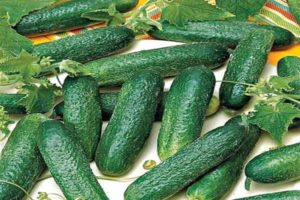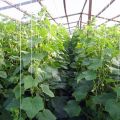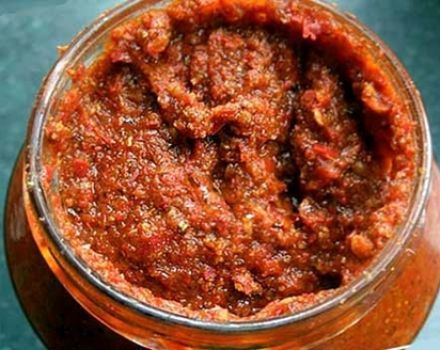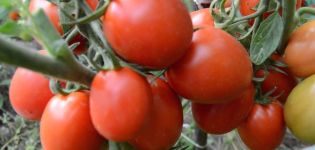Growing and caring for eggplants in the same greenhouse with cucumbers, is it possible
Is it possible plant eggplant together with other vegetables indoors? Solanaceous crops are very demanding to care for and do not always get along with other vegetables, especially if grown in a greenhouse.
Growing conditions
Growing and caring for eggplants with cucumbers in a greenhouse has its own characteristics. Each of these vegetables is characterized by similar and distinctive care and growth aspects.
In order to get a rich and high-quality eggplant crop, certain conditions must be observed in the greenhouse:
- the air must be dry and warm (about 28 degrees);
- you need to provide free access to sunlight to the plantings;
- watering is recommended only with warm water directly under the root;
- cultivation involves tying and pinching.
During the formation of color on blue seedlings, it is necessary to cut off the extra small and weak flowers. Otherwise, the fruits are small and misshapen.
From the moment of planting the seeds to the appearance of fruits, an average of 115 days pass. In order to harvest even earlier in the greenhouse, gardeners also plant other vegetable crops.
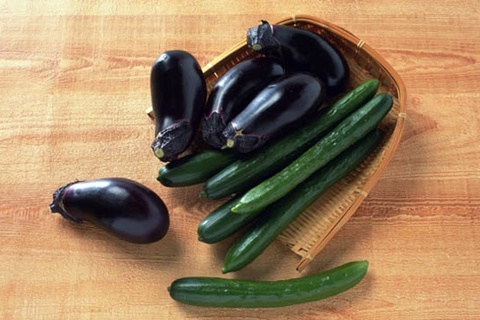
Blue ones can be planted with sweet peppers. These two vegetables get along well and require the same care. Watering them is enough 1-2 times a week. Water consumption is about 2 liters at the root. During flowering, watering should be increased up to 3 times.
After watering, it is imperative to loosen the ground so that oxygen and nutrients can better penetrate into the plant. But you need to loosen the soil carefully, since the root branches are very vulnerable and are located close to the soil surface. For the entire growing season, it is necessary to apply mineral and organic fertilizers, at least 3 times.
You can plant eggplants with any legumes, Chinese cabbage, radishes, basil, onions. This neighborhood will not cause any discomfort.
The neighborhood of blue with tomatoes is not very successful. Tomatoes require a lot of moisture, and many varieties tolerate shading well, but do not tolerate heat well. If the air is too warm, tomatoes will lose their ovaries.
Tomatoes attract many pests. Eggplant is watered more often and more abundantly. Excess moisture leads to the development of fungus and other diseases.
Cucumbers ripen quite quickly. From the moment the first shoots appear, only 38-40 days can pass. There are peculiarities of growing cucumbers:
- the air in the greenhouse should be humid and equal to about 19 degrees;
- the soil must be well fertilized, at least three times during the entire growing season;
- watered often with warm, settled water;
- timely treatment against pests and diseases.
For greenhouses, it is better to choose hybrids that do not require insect pollination. The fruits are juicy, dense and crunchy, without bitterness in the taste.
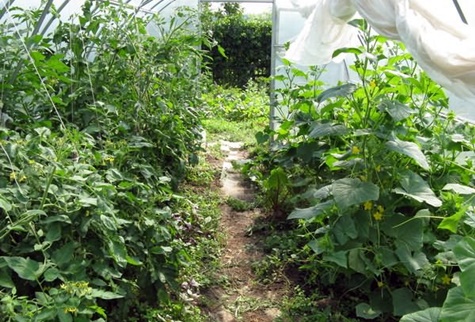
Possible neighborhood
The neighborhood of eggplants with cucumbers is not in the best way, but to grow, perhaps observing some rules. If the neighborhood cannot be avoided, then the eggplants should be planted along the wall, where there is enough sunlight. The cucumbers should be planted on the opposite side so that their dense plantings do not obscure the eggplant beds.
Cucumbers require a lot of moisture to grow and develop. Therefore, the root system will absorb water and trace elements from the soil without leaving them to the eggplants.
When planting eggplants along with cucumbers, it must be borne in mind that the latter need to be watered more often. Moisture affects the development of blue vegetables. Eggplants are best planted along the south side and cucumbers along the north.
While eggplants need dry and hot air, cucumbers like moist, cool air around 20 degrees. Therefore, if the eggplants are planted next to the cucumbers, then with dry air, the inflorescences of the latter begin to fall off.
During the period of fruit formation, eggplants must be ventilated. Drafts are contraindicated for cucumbers. The planted vegetables will wither and the yield may be reduced.
The only similar requirement when growing both crops is soil composition and fertilization. The soil, these vegetable crops love loose and light. Fertilizers can also be applied the same.

Solution to the problem
Not everyone has the opportunity to install several greenhouses on the site. Therefore, the issue can be resolved with the help of zoning, then the compatibility of blue vegetables with green ones will be possible. The room is divided into several zones. You can additionally organize another entrance to the greenhouse and make a partition made of polycarbonate, oilcloth or polyethylene.
A partition or additional entrance will solve many problems. For example, if tomatoes and eggplants are planted at the same time, you can calmly air the first and water the second.
If it is not possible to make a second entrance to the greenhouse, then you can simply make a partition through which you should pass only when necessary. The partition is able to protect from the spread of pests and maintain the necessary microclimate.
Eggplants belong to the self-pollinating group of plants, so you need to choose varieties of cucumbers that do not require pollination by bees.
You need to plant crops in different beds. Can be placed on opposite sides or placed eggplant near the walls of the greenhouseand cucumbers in the middle. The sides of the greenhouse are much warmer and more illuminated.
If there is a lot of space left between cucumbers and eggplants in one greenhouse, then you can plant beans. It is able to enrich the soil with nitrogen, grows quickly and bears fruit well in a greenhouse.
Meeting with diseases and pests
Growing cucumbers next to eggplants, gardeners often face the development of diseases and pests. These plants are often attacked by aphids and spider mites. Insects damage seedlings and can carry many infectious diseases that spread at great speed.
Before planting seeds or seedlings of cucumbers and eggplants, you need to carry out disinfecting measures. It is necessary to disinfect not only the soil, but also the structure of the greenhouse, as well as garden tools.
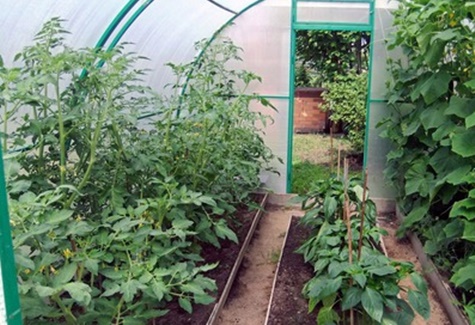
In order to prevent the disease or notice it in time, you need to know a few rules:
- periodically you need to inspect the plantings, especially the inside of the leaves;
- if a change in the color of the leaves is detected, the appearance of spots, larvae of pests or adults, it is necessary to treat with insecticides;
- onion or garlic infusion, wood ash infusion with the addition of laundry soap will help prevent or get rid of pests.
Fertilizers will saturate plants with essential nutrients and increase disease resistance. The best options for vegetable crops are manure and humus. One has only to remember that fresh manure cannot be introduced into the soil, so as not to burn the plant root system.

